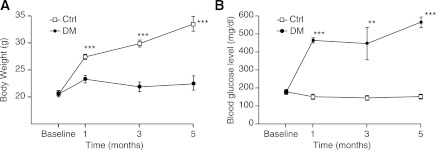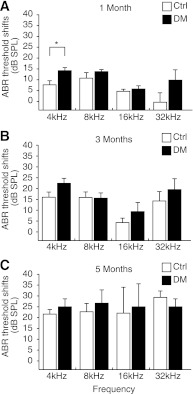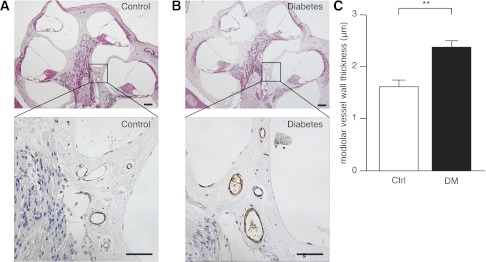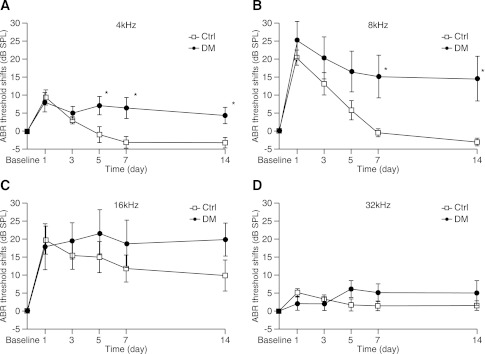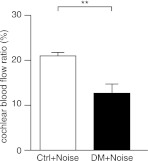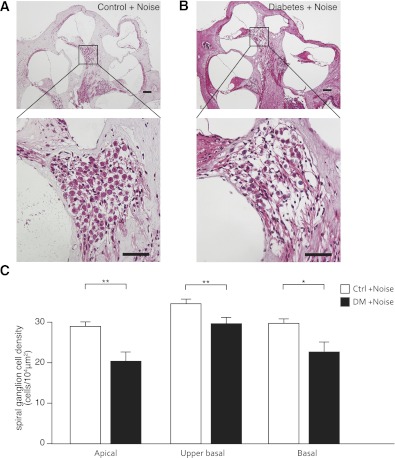Abstract
We aimed to investigate the pathophysiology of diabetes-associated hearing impairment in type 1 diabetes using mice with streptozotocin-induced diabetes (C57BL/6J; male). Hearing function was evaluated 1, 3, and 5 months after induction of diabetes (five diabetic and five control animals per time point) using auditory-evoked brain stem responses (ABRs). Mice (four diabetic and four control) were exposed to loud noise (105 dB) 5 months after induction of diabetes. ABRs were measured before and after noise exposure. Cochlear blood flows were measured by laser-Doppler flowmeter. Spiral ganglion cells (SGCs) were counted. Vessel endothelial cells were observed by CD31 immunostaining. Chronologic changes in the ABR threshold shift were not significantly different between the diabetic and control groups. However, vessel walls in the modiolus of the cochleae were significantly thicker in the diabetic group than the control group. Additionally, recovery from noise-induced injury was significantly impaired in diabetic mice. Reduced cochlea blood flows and SGC loss were observed in diabetic mice cochleae after noise exposure. Our data suggest that diabetic cochleae are more susceptible than controls to loud noise exposure, and decreased cochlear blood flow due to sclerosis of the vessels and consequent loss of SGCs are possible mechanisms of hearing impairment in diabetic patients.
At present, >278 million people worldwide have a disabling hearing impairment (1). Hearing impairment leads to difficulty in conversation, music appreciation, orientation to alarms, and participation in social activities. Hearing loss is typically classified as conductive, sensorineural, or mixed. Conductive hearing loss results from pathologic changes to either the external or the middle ear structures blocking the sound waves from reaching the fluids of the inner ear. Sensorineural hearing loss results from pathologic changes of inner ear structures such as the cochlea or the auditory nerve and impedes transmission of neural impulses to the auditory cortex of the brain. Sensorineural hearing loss can be congenital or can be acquired because of prolonged exposure to loud noises, ototoxic substances, ear diseases, or systemic disease such as hypertension, hyperlipidemia, and diabetes (2,3). However, the impact of diabetes on hearing impairment has not been as well recognized until recently in comparison with the known microvascular complications affecting the renal, visual, and peripheral nervous systems.
Jordao (4) first reported the association between diabetes and hearing loss in 1857. Since then, a number of clinical studies have been conducted to investigate the possible relation of diabetes and hearing loss, with inconsistent conclusions (5–9). Some reported negative results (10,11). Recently, using a large population-based dataset, Bainbridge, Hoffman, and Cowie concluded that diabetes is an independent risk factor for hearing loss (12). In addition, interactions between noise exposure and diabetes were reported (13,14).
Histopathological studies on the temporal bones of patients with diabetes reported thickened vessels of the stria vascularis, atrophy of the stria vascularis, and loss of outer hair cells (OHCs) in the cochlea (15,16). Thickening of the cochlear modiolar vessel walls (17) and microangiopathic involvement of the endolymphatic sac and/or basilar membrane vessels (18) were also reported as characteristic diabetes-related changes in the cochlea. These reports suggested that microangiopathy was a common change in the cochlea of the patients with diabetes, in addition to the changes in the renal, visual, and peripheral nervous systems.
Studies in animal models have also shown an association between diabetes and hearing loss. A longitudinal study on diabetic rats (WBN/Kob) showed hearing impairment compared with age-matched Wistar rats (19). In middle-aged mice, type 2 diabetes induced by a high-fat diet led to significant hearing impairment over a period of 6 months. Although mice with streptozotocin (STZ)-induced type 1 diabetes showed only a slight hearing impairment in a normal quiet setting (20), recovery of hearing function after noise exposure was impaired in STZ rats (21).
Morphologically, loss of OHCs (19,22–25) and inner hair cells (IHCs) (22) has been reported in diabetic rodent models. Changes in intermediate and marginal cells of the stria vascularis (19,22,23), degeneration of spiral ganglion cells (SGCs) (19,25), and thickening of the basement membranes of capillaries in the stria vascularis (26) have also been reported. However, another study did not find any of these changes in diabetic rats (27).
To date, although there are a number of studies investigating hearing function and cochlear morphology in diabetic rodents, reports on the pathophysiology underlying diabetes-associated hearing impairment are still inconsistent. Therefore, we conducted this study to elucidate the mechanisms by which diabetes affects the cochleae. We assessed physiological and morphological alterations in the cochleae over time in mice with STZ-induced diabetes. We then tested the hypothesis that diabetes may primarily affect the inner ear by increasing its sensitivity to environmental stress. This we tested by comparing the sensitivity to noise-induced hearing loss in normal mice versus mice with STZ-induced diabetes.
RESEARCH DESIGN AND METHODS
Animals and induction of diabetes.
Thirty-eight C57BL/6J mice (8 weeks old; male) were used in this study. All animal procedures were approved by the Institutional Animal Care and Use Committee guidelines of Kobe University Graduate School of Medicine. Animals were maintained on a normal diet under standard animal house conditions. Mice in the diabetic group were injected with STZ (100 mg/kg body wt i.p. in 100 μL sterile citrate buffer, pH 4.5; Sigma Chemical Co, St Louis, MO) on two consecutive days (28). Mice in the control group were injected with physiological saline. Mice with venous blood glucose levels of >306 mg/dL, in samples obtained from the tail and measured by Glutest-Ace (Sanwa Kagaku Kenkyusho, Nagoya, Japan), were considered diabetic. Body weight and venous blood glucose levels were measured at baseline (pretreatment) and 1, 3, and 5 months after STZ or physiological saline injection.
Experimental protocol.
Animals were randomly assigned to control or diabetic groups. They were then divided into the following subgroups: 1-month group (diabetes, n = 5; control, n = 5), 3-month group (diabetes, n = 5; control, n = 5), 5-month group (diabetes, n = 5; control, n = 5), and noise-exposed group (diabetes, n = 4; control, n = 4). Mice were followed for 5 months after STZ injection because mortality rate was 20% at 6 months after STZ injection in the preliminary experiment.
In each subgroup, hearing function was measured by auditory-evoked brain stem responses (ABRs) at baseline (pretreatment). The hearing function of mice in the 1-, 3-, and 5-month groups was also measured using ABRs at 1, 3, or 5 months after injection of STZ or physiological saline. After the last ABR measurements, cochlear blood flow was measured. Then mice were immediately killed and cochleae were removed. The mice in the noise-exposed group were exposed to loud noise 5 months after injection of STZ or physiological saline. In the noise-exposed group, ABR was performed immediately before the exposure and 1, 3, 5, 7, and 14 days after the noise exposure. After completion of ABR, cochlear blood flow was measured and cochleae were removed.
Hearing measurements.
ABR was measured in both ears of each animal. Prior to measurements, animals were anesthetized with midazolam (10 mg/kg i.p.), medetomidine (37.5 μg/kg i.p.), and butorphanol tartrate (0.5 mg/kg i.p.). ABR measurement was performed using waveform storing and stimulus control with Scope software on the PowerLab system (PowerLab2/26; AD Instruments, Castle Hill, Australia), and electroencephalogram (EEG) recording was performed with the extracellular amplifier AC PreAmplifier (P-55; Astro-Med, West Warwick, RI). Sound stimuli were produced by a coupler-type speaker (ES1spc; Bio Research Center, Nagoya, Japan) inserted into the external auditory canal of mice. Tone burst stimuli, with a 0.2 ms rise/fall time (cosine gate) and 1-ms flat segment at frequencies of 4, 8, 16, and 32 kHz, were generated, and the amplitude was specified by a sound generator and attenuation Real-Time Processor and Programmable Attenuator (RP2.1and PA5; Tucker-Davis Technologies). Sound-level calibrations were performed using a Sound Level Meter (NA-42; Rion, Tokyo, Japan). For recording, stainless steel needle electrodes were placed at the vertex and ventrolateral to the left and right ears. Generally, ABR waveforms were recorded for 12.8 ms at a sampling rate of 40,000 Hz using 50- to 5,000-Hz band-pass filter settings; waveforms from 256 stimuli at a frequency of 9 Hz were averaged. ABR waveforms were recorded in 5-dB sound pressure level (SPL) intervals down from a maximum amplitude until no waveform could be visualized.
Noise exposure.
Animals were exposed in pairs, in separate cages, to one-octave band noise (OBN) centered at 4 kHz, at 105-dB SPL for 2 h (temporary threshold shift [TTS] model), in a ventilated sound-exposure chamber. The sound chamber was fitted with speakers (HFD-261-8 and LE-M94; TOA, Kobe, Japan) driven by a noise generator (SF-06, Rion, and DEQ2496, Boehringer, Willich, Germany) and power amplifier (DA-250D; TOA). The stimulus intensity varied by a maximum of 3 dB across measured sites within the exposure chamber. During noise exposure, noise levels were monitored with a sound level meter (NL-20; Rion), a preamplifier, and a condenser microphone. The microphone was positioned within the cage at the approximate level of the animal’s head.
Measurement of cochlear blood flow.
The left tympanic bulla of the mice was exposed and opened under deep anesthesia. With a laser-Doppler flowmeter (TBF-LN1; Unique Medical, Tokyo, Japan), cochlear blood flow was measured using a 0.5-mm-diameter laser-Doppler probe placed over the lateral wall of the cochlea. The operating principle of the laser-Doppler flowmeter has previously been described in detail (29,30). Blood flow of the stapedial artery was also measured. Blood flow ratio was determined as the laser-Doppler output of the cochlear lateral wall divided by that of the stapedial artery.
Histological preparations.
After measurement of cochlear blood flow under deep anesthesia, the temporal bones were immediately removed and transferred into 4% paraformaldehyde in 0.1 mol/L PBS (pH 7.4). Under a dissecting microscope, the round and oval windows and the cochlear capsule near the apex were opened, followed by gentle local perfusion of 4% paraformaldehyde from the apex. The tissues were kept in fixative at 4°C for 24 h. After overnight fixation, cochleae were decalcified with 10% ethylenediaminetetraacetic acid disodium salt dihydrate (pH 7.0; Muto Pure Chemicals, Tokyo, Japan) at room temperature for 2 days. Cochleae were dehydrated through a graded ethanol series and xylene, embedded in paraffin, and then sectioned at 3.0 μm in the midmodiolar plane.
Morphological analysis.
The slides containing cochlea sections were stained with hematoxylin-eosin (H-E) (hematoxylin from Muto Pure Chemicals; eosin from Wako Pure Chemicals Industries, Osaka, Japan) to study the structure. The specimens were examined with a laboratory microscope (BX51; Olympus, Tokyo, Japan).
Immunohistochemical staining for CD31.
The paraformaldehyde-fixed, paraffin-embedded specimens were deparaffinized and rehydrated through a graded xylene and alcohol series. The sections were then placed in a citrate-buffered solution (pH 6.0) and heated at 100°C in a microwave oven for 10 min. Endogenous peroxidase was blocked with 3% hydrogen peroxide, and nonspecific binding was blocked with 10% normal rabbit serum for 15 min. The sections were then incubated with the polyclonal anti-CD31 antibody (DIA 310, diluted 1:20; Dianova, Hamburg, Germany) at room temperature for 30 min, washed in PBS, and incubated with biotinylated anti-Rat IgG (diluted 1:200; Vector Laboratories, Burlingame, CA). Antibody binding was visualized with the Elite ABC kit (Vector Laboratories). Diaminobenzidine was used for coloration, and nuclei were counterstained with hematoxylin.
Evaluation of cochlear vessels.
The sections stained by immunohistochemistry for CD31, which labels the endothelial cells of blood vessels, were used to study the morphological changes of cochlear vessels. Three midmodiolar sections separated by 30 μm were selected in each temporal bone, with the average defined as the data for the animal. Perpendicular cross-sections of the spiral modiolar artery were used to study the cochlear vessels. The most perpendicularly sectioned vessel was selected for observation in each subject. The cochlear specimens were examined with a light microscope system (BZ-8100; Keyence, Osaka, Japan) and saved as digital images. For measurement of the area of vessel walls, the CD31-positive area was measured using a VH Analyzer VH-H1A5 (Keyence) and calculated with reference to methods previously described (31).
The vessel wall area (VWA) and vessel wall length (VWL) per vessel cross-section were determined using the following formulae: VWA = T-Lu and VWL = (outer length of lines delimiting VWA + inner length of lines delimiting VWA)/2, where T is the total cross-sectional area of each vessel and Lu is the luminal area. Vessel wall thickness in each vessel was expressed as VWA/VWL.
Spiral ganglion cell count.
In the current study, the cochlea was divided into three half turns (basal, upper basal, and apical). Morphometric assessments of SGCs were performed for each cochlear turn on the H-E–stained sections. The cochlear specimens were observed and photographed with a BZ-8100 light microscope, and digital images were saved. The areas of Rosenthal canal and the cochlear turn were quantified by measuring their cut surfaces using VH-H1A5. All neurons meeting the size and shape criteria to be considered type 1 SGCs within each profile of Rosenthal canal were counted for each cochlear turn. The SGC density was determined as the number of cell nuclei per 10,000 μm2 Rosenthal canal. We calculated the SGC density as previously described (32) in three midmodiolar sections 30 μm apart from each cochlea, with the average defined as the data for the animal.
Statistical analysis.
The overall effect on ABR threshold shifts, vessel wall thickness, ABR threshold shifts after noise exposure, cochlear blood flow, and SGC density was assessed by a nonpaired t test (STATA 11.1; STATA, College Station, TX). A P value <0.05 was considered statistically significant. All data are represented as means ± SE.
RESULTS
Body weight and blood glucose levels in control and diabetic mice.
Changes in body weight and blood glucose levels during the study are shown in Fig. 1. Body weight increased steadily in control mice throughout the 5-month observation period. In contrast, diabetic mice showed little gain in weight. Body weights of the diabetic animals were significantly decreased compared with those of controls at 1, 3, and 5 months of the experiment (Fig. 1A). Blood glucose levels in the control group did not change throughout the experimental period. The blood glucose levels were significantly higher in the diabetic group than in the control group throughout the experiment (Fig. 1B). Of animals injected with STZ, 91.4% (32 per 35, including preliminary experiments) showed elevations in blood glucose sufficient for diabetes classification.
FIG. 1.
Time course of changes in body weight (A) and blood glucose level (B) at baseline (n = 15 each for diabetic [DM] and control [Ctrl]) and 1 month (n = 15 each for diabetic and control), 3 months (n = 10 each for diabetic and control), and 5 months (n = 5 each for diabetic and control) after induction of diabetes. Data are means ± SE. **P < 0.01, ***P < 0.001 diabetic vs. control group.
Time course of ABR threshold shift through the 5-month observation.
The diabetic group showed slightly higher ABR threshold elevations compared with controls, but these differences did not reach statistical significance throughout the experiment at all ABR frequencies (4, 8, 16, and 32 kHz) except at 4 kHz at 1 month (Fig. 2). ABR threshold was elevated in both the diabetic and control groups as they grew older throughout the observation period.
FIG. 2.
Chronologic changes in the ABR threshold shift were not significantly different between the diabetic group and controls throughout the observation period except at 4 kHz at 1 month. The time course of ABR threshold shifts compared with baseline (A–C) at each observation period (1, 3, and 5 months) for the diabetic (DM) group (n = 5 for each period) and control (Ctrl) group (n = 5 for each period). Data are means ± SE. *P < 0.05 diabetic vs. control group.
Histological changes in cochleae.
At 5 months after injection, the CD31-positive staining area in vessel walls at the modiolus of the cochlea was significantly broader in the diabetic mice than in controls (Fig. 3A and B), indicating that vessel walls in the modiolus of the cochleae were thickened in the diabetic group. A significant difference was observed in the mean vessel wall thickness between the diabetic group and the control group (2.29 vs. 1.68 μm, P = 0.002) (Fig. 3C). There was no difference in the lateral cochlear wall including stria vascularis between diabetic and normal cochleae at 1, 3, and 5 months after injection. IHCs and OHCs were well preserved in both diabetic and control mice.
FIG. 3.
H-E staining (top panel; scale bar = 100 μm) and CD31 immunostaining (bottom panel; scale bar = 20 μm) of the vessel endothelial cells at the modiolus in control (Ctrl) cochlea (A) and diabetic (DM) cochlea (B). The vessel wall thickness of staining for CD31, quantified by a computer-aided image-analysis system, is shown for both diabetic (n = 5) and control (n = 5) mice at 5 months of diabetes as described in research design and methods (C). Data are means ± SE. **P < 0.01 diabetic vs. control group. (A high-quality digital representation of this figure is available in the online issue.)
Time course of ABR threshold shifts after exposure to noise.
Compared with baseline, ABR thresholds at frequencies of 4, 8, and 16 kHz shifted markedly at day 1 after noise exposure for both control and diabetic mice (Fig. 4). In general, ABRs (4 and 8 Hz particularly) in diabetic mice after exposure showed a delayed recovery of TTS components and a significant increase in permanent threshold shift. ABR thresholds in the control group recovered to baseline by day 7 at 4 and 8 kHz. At 4 kHz, recovery from TTS was significantly delayed in the diabetic group compared with the control group at days 5, 7, and 14 (Fig. 4A). At 8 kHz, recovery from TTS was also significantly delayed in the diabetic group compared with the control group at days 7 and 14 (Fig. 4B). At 16 and 32 kHz, ABR threshold shifts in the diabetic group showed a tendency toward delayed recovery from TTS compared with the control group, but this difference did not reach statistical significance (Fig. 4C and D).
FIG. 4.
Recovery from noise-induced injury was significantly impaired in diabetic mice at 4 and 8 kHz. The time course of ABR threshold shifts at each frequency in diabetic (DM) (n = 4) and control (Ctrl) (n = 4) groups after noise exposure (4-kHz OBN, 105-dB SPL for 2 h) (A–D). Data are means ± SE. *P < 0.05 diabetic vs. control group.
Cochlear blood flow.
A significant difference was observed in the blood flow ratio of cochleae in diabetic and control groups (12.8 and 21.1%) at 14 days after noise exposure (Fig. 5). Cochlear blood flow after noise exposure was significantly decreased in the diabetic group compared with the control group (P = 0.005). In contrast, there was no significant difference in the blood flow ratio of cochleae between diabetic and control groups at 1, 3, and 5 months after injection (data not shown).
FIG. 5.
The cochlear blood flow ratio measured by laser-Doppler flowmeter is shown for both diabetic (DM) (n = 4) and control (Ctrl) (n = 4) mice 14 days after noise exposure (4-kHz OBN, 105-dB SPL for 2 h) as described in research design and methods. Data are means ± SE. **P < 0.01 diabetic vs. control group.
Loss of SGCs.
Loss of the type 1 SGCs was observed in all portions of the cochlea in the diabetic group at 14 days after noise exposure. Figure 6 shows the representative sections of Rosenthal canal in the apical turn of the cochlea of the control group (Fig. 6A) and diabetic group (Fig. 6B). The average numbers of SGCs in the diabetic and control groups 14 days after noise exposure were 20.2/10,000 and 28.8/10,000 μm2 in the apical turn, 29.7/10,000 and 36.8/10,000 μm2 in the upper-basal turn, and 23.5/10,000 and 30.4/10,000 μm2 in the basal turn, respectively (Fig. 6C). The numbers of SGCs after noise exposure were significantly decreased in all portions of the cochleae in the diabetic group in comparison with the control group. In contrast, the average numbers of SGCs in the diabetic and control groups without noise exposure were 28.8/10,000 and 30.1/10,000 μm2 in the apical turn, 32.6/10,000 and 33.7/10,000 μm2 in the upper-basal turn, and 33.9/10,000 and 33.3/10,000 μm2 in the basal turn, respectively. There was no significant difference between the diabetic and control groups without noise exposure. The lateral wall of cochleae including the stria vascularis, IHCs, and OHCs were well preserved in both the diabetic group and controls after noise exposure.
FIG. 6.
A and B: Whole cochleae (top panels; scale bar = 100 μm) and SGCs in the apical turn of the cochleae (bottom panels; scale bar = 50 μm) 14 days after noise exposure (4-kHz OBN, 105-dB SPL for 2 h). H-E staining of control [Ctrl] cochlea (A) and diabetic (DM) cochlea (B). Means of the densities of spiral ganglion neurons 14 days after noise exposure are shown in C (n = 4 for each group). Data are means ± SE. *P < 0.05, **P < 0.01 diabetic vs. control group. (A high-quality digital representation of this figure is available in the online issue.)
DISCUSSION
In the current study, ABR thresholds shifted with aging in both the diabetic and control groups. This was as expected because the C57BL/6 mice used in the current study are well-known to develop sensorineural hearing loss much earlier in life than other mice (33–35). However, no significant differences in aging-related hearing impairment were observed between the diabetic and control mice, in accordance with a previous study using the STZ-induced diabetes model in CBA/CaJ mice (20) but in contrast with findings from the rat model of chronic pancreatitis and spontaneous diabetes (19). Most interestingly, we showed that recovery from noise-induced injury was significantly impaired in an experimental diabetes model, consistent with a previous report using the STZ-induced diabetes rat model (21).
These results are quite compatible with the clinical features of hearing loss in human patients with diabetes, as patients with a long history of severe diabetes do not necessarily suffer from hearing impairment. Moreover, several studies have reported that patients with diabetes are prone to noise-induced hearing loss. One cross-sectional study suggested that diabetic workers were more prone to developing severe noise-induced hearing loss (13). Another survey observed significant interactions between firearm noise exposure and hearing loss in diabetic patients at 3 kHz (36). Automobile company workers with high fasting blood glucose levels showed significantly higher hearing thresholds at 4 kHz than workers with normal fasting glucose levels (14). These studies and ours suggest that patients with diabetes are potentially more susceptible to noise-induced hearing loss. The current study suggests that this may be attributed to impaired recovery from noise injury. As a result of accumulated damage from noise as well as other factors such as ototoxic agents and infections, hearing impairment may become relevant among people with diabetes.
Pathologically, endothelial dysfunction is a common mechanism for renal and other chronic vascular complications in diabetes (37). Therefore, it is noteworthy that in the current study thickening of the modiolar vessel walls was the most characteristic morphological change in the diabetic mice. Thickening of the wall of the modiolar artery has also been observed in the temporal bone in a patient with diabetes (17). The cochlea is supplied with its blood flow by the spiral modiolar artery and the cochlear branch of the vestibule cochlear artery, which are terminal branches of the inner ear artery (38). We therefore hypothesized that the morphological changes observed in the modiolar vessels might induce circulatory disturbances in diabetic cochleae.
To test this hypothesis, we studied the blood flow in mouse cochlea. Indeed, cochlear blood flows in diabetic mice appeared lower than those in normal mice. While there was no significant difference in the blood flow in cochleae between diabetic and control mice 5 months after injection under normal conditions, the difference in cochlear blood flow between the two groups became obvious after noise exposure. Blood flow is influenced by depth of anesthesia or systemic blood pressure. Thus, it is difficult to determine the baseline of cochlear blood flow. Assessments of dynamic responsiveness for vasoconstrictor or dilator applied to the round window have been reported (39) as a method for measuring the vascular conductance. In this study, to exclude the influence of systemic blood pressure we applied the blood flow ratio (blood flow of cochlear lateral wall to blood flow of stapedial artery). The cochlea is supplied principally by the inner ear artery (labyrinthine artery), which is a branch of the anterior inferior cerebellar artery (38), while the stapedial artery, a branch of the internal carotid artery, supplies the middle ear and the surrounding bone of the cochlea. Because the stapedial artery and the anterior inferior cerebellar artery do not communicate directly with each other (40), laser-Doppler output of the stapedial artery can be considered to reflect systemic blood pressure. Reduced cochlear blood flow has significant implications for metabolic homeostasis in the cochlea because cellular metabolism clearly depends on adequate supply of O2 and nutrients as well as elimination of waste products (41). Hence, the reduction in cochlear blood flow induced by intense noise exposure might cause the impairment of recovery from TTS in diabetic mice.
Noise exposure causes sensory cell death and auditory nerve death resulting from metabolically initiated changes including formation of free radical species (41,42). Ischemia in the cochlea itself has been shown to lead to hair cell death via apoptosis and cause delayed cell death in the SGCs (41). However, in the current study, diabetic mice exhibited significant loss of SGCs in the cochlea after noise exposure, while IHCs and OHCs were preserved. A recent report indicates that noise exposure causes acute loss of afferent nerve terminals and delayed loss of the SGCs even when hair cells are well preserved (43). Taken together, these results suggest that deterioration of walls of the modiolar vessel supplying the SGCs combined with ischemic changes and loss of cochlear synaptic terminals induced by noise exposure causes death of SGCs resulting in irreversible impairment of hearing.
In conclusion, the current study suggests that diabetic cochleae are more susceptible than controls to loud noise exposure. Long-term diabetes status leads to thickening of modiolar vessel walls and reduced cochlear blood flow after noise exposure. Disrupted microcirculation may cause loss of SGCs and irreversible hearing impairment. One limitation of the current study is low sample size. However, the authors believe that the trend is clear from the quantitative results and anatomical changes. Further studies should be performed to develop new strategies for prevention and treatment of hearing impairment in patients with diabetes.
ACKNOWLEDGMENTS
This work was supported by Grant-in-Aid for Young Scientists (B) (23791896 to T.F. and 20791191 to H.T.) and Grant-in-Aid for Scientific Research (C) (23592482 to D.Y.) from the Ministry of Education, Culture, Sports, Science, and Technology of Japan.
No potential conflicts of interest relevant to this article were reported.
T.F. researched data, contributed to discussion, and prepared the manuscript. D.Y. and S.K. researched data, contributed to discussion, and reviewed and edited the manuscript. S.H. and H.T. contributed to discussion. K.-i.N. contributed to discussion and reviewed and edited the manuscript. T.F. is the guarantor of this work and, as such, had full access to all the data in the study and takes responsibility for the integrity of the data and the accuracy of the data analysis.
Parts of this study were presented in abstract form and as a poster at the 34th Annual Midwinter Research Meeting of the Association for Research in Otolaryngology, Baltimore, Maryland, 19–23 February 2011.
The authors thank H. Matsunaga, Department of Otolaryngology–Head and Neck Surgery, Kobe University Graduate School of Medicine, for excellent technical assistance.
REFERENCES
- 1.Tucci D, Merson MH, Wilson BS. A summary of the literature on global hearing impairment: current status and priorities for action. Otol Neurotol 2010;31:31–41 [DOI] [PubMed] [Google Scholar]
- 2.Bagai A, Thavendiranathan P, Detsky AS. Does this patient have hearing impairment? JAMA 2006;295:416–428 [DOI] [PubMed] [Google Scholar]
- 3.Gates GA, Mills JH. Presbycusis. Lancet 2005;366:1111–1120 [DOI] [PubMed] [Google Scholar]
- 4.Jordao AMD. Consideration sur un cas du diabete. Union Medicale du Paris 1857;11:446 [Google Scholar]
- 5.Cullen JR, Cinnamond MJ. Hearing loss in diabetics. J Laryngol Otol 1993;107:179–182 [DOI] [PubMed] [Google Scholar]
- 6.Dalton DS, Cruickshanks KJ, Klein R, Klein BE, Wiley TL. Association of NIDDM and hearing loss. Diabetes Care 1998;21:1540–1544 [DOI] [PubMed] [Google Scholar]
- 7.Kakarlapudi V, Sawyer R, Staecker H. The effect of diabetes on sensorineural hearing loss. Otol Neurotol 2003;24:382–386 [DOI] [PubMed] [Google Scholar]
- 8.Austin DF, Konrad-Martin D, Griest S, McMillan GP, McDermott D, Fausti S. Diabetes-related changes in hearing. Laryngoscope 2009;119:1788–1796 [DOI] [PMC free article] [PubMed] [Google Scholar]
- 9.Uchida Y, Sugiura S, Ando F, Nakashima T, Shimokata H. Diabetes reduces auditory sensitivity in middle-aged listeners more than in elderly listeners: a population- based study of age-related hearing loss. Med Sci Monit 2010;16:PH63–PH68 [PubMed] [Google Scholar]
- 10.Strauss P, Schneider K, Terriuolo V, Sachsse B. [Inner ear and diabetes mellitus studies on 660 patients]. Laryngol Rhinol Otol (Stuttg) 1982;61:331–338 [in German] [PubMed] [Google Scholar]
- 11.Miller JJ, Beck L, Davis A, Jones DE, Thomas AB. Hearing loss in patients with diabetic retinopathy. Am J Otolaryngol 1983;4:342–346 [DOI] [PubMed] [Google Scholar]
- 12.Bainbridge KE, Hoffman HJ, Cowie CC. Diabetes and hearing impairment in the United States: audiometric evidence from the National Health and Nutrition Examination Survey, 1999 to 2004. Ann Intern Med 2008;149:1–10 [DOI] [PMC free article] [PubMed] [Google Scholar]
- 13.Ishii EK, Talbott EO, Findlay RC, D’Antonio JA, Kuller LH. Is NIDDM a risk factor for noise-induced hearing loss in an occupationally noise exposed cohort? Sci Total Environ 1992;127:155–165 [DOI] [PubMed] [Google Scholar]
- 14.Jang TW, Kim BG, Kwon YJ, Im HJ. The association between impaired fasting glucose and noise-induced hearing loss. J Occup Health 2011;53:274–279 [DOI] [PubMed] [Google Scholar]
- 15.Fukushima H, Cureoglu S, Schachern PA, et al. Cochlear changes in patients with type 1 diabetes mellitus. Otolaryngol Head Neck Surg 2005;133:100–106 [DOI] [PubMed] [Google Scholar]
- 16.Fukushima H, Cureoglu S, Schachern PA, Paparella MM, Harada T, Oktay MF. Effects of type 2 diabetes mellitus on cochlear structure in humans. Arch Otolaryngol Head Neck Surg 2006;132:934–938 [DOI] [PubMed] [Google Scholar]
- 17.Kariya S, Cureoglu S, Fukushima H, et al. Comparing the cochlear spiral modiolar artery in type-1 and type-2 diabetes mellitus:a human temporal bone study. Acta Med Okayama 2010;64:375–383 [DOI] [PubMed] [Google Scholar]
- 18.Wackym PA, Linthicum FH., Jr Diabetes mellitus and hearing loss: clinical and histopathologic relationships. Am J Otol 1986;7:176–182 [PubMed] [Google Scholar]
- 19.Ishikawa T, Naito Y, Taniguchi K. Hearing impairment in WBN/Kob rats with spontaneous diabetes mellitus. Diabetologia 1995;38:649–655 [DOI] [PubMed] [Google Scholar]
- 20.Vasilyeva ON, Frisina ST, Zhu X, Walton JP, Frisina RD. Interactions of hearing loss and diabetes mellitus in the middle age CBA/CaJ mouse model of presbycusis. Hear Res 2009;249:44–53 [DOI] [PMC free article] [PubMed] [Google Scholar]
- 21.Wu HP, Cheng TJ, Tan CT, Guo YL, Hsu CJ. Diabetes impairs recovery from noise-induced temporary hearing loss. Laryngoscope 2009;119:1190–1194 [DOI] [PubMed] [Google Scholar]
- 22.Nakae S, Tachibana M. The cochlea of the spontaneously diabetic mouse. II. Electron microscopic observations of non-obese diabetic mice. Arch Otorhinolaryngol 1986;243:313–316 [DOI] [PubMed] [Google Scholar]
- 23.Tachibana M, Nakae S. The cochlea of the spontaneously diabetic mouse. I. Electron microscopic observation of KK mice. Arch Otorhinolaryngol 1986;243:238–241 [DOI] [PubMed] [Google Scholar]
- 24.Rust KR, Prazma J, Triana RJ, Michaelis OE, 4th, Pillsbury HC. Inner ear damage secondary to diabetes mellitus. II. Changes in aging SHR/N-cp rats. Arch Otolaryngol Head Neck Surg 1992;118:397–400 [DOI] [PubMed] [Google Scholar]
- 25.Raynor EM, Carrasco VN, Prazma J, Pillsbury HC. An assessment of cochlear hair-cell loss in insulin-dependent diabetes mellitus diabetic and noise-exposed rats. Arch Otolaryngol Head Neck Surg 1995;121:452–456 [DOI] [PubMed] [Google Scholar]
- 26.Smith TL, Raynor E, Prazma J, Buenting JE, Pillsbury HC. Insulin-dependent diabetic microangiopathy in the inner ear. Laryngoscope 1995;105:236–240 [DOI] [PubMed] [Google Scholar]
- 27.Nageris B, Hadar T, Feinmesser M, Elidan J. Cochlear histopathologic analysis in diabetic rats. Am J Otol 1998;19:63–65 [PubMed] [Google Scholar]
- 28.Hamada Y, Kitazawa S, Kitazawa R, Fujii H, Kasuga M, Fukagawa M. Histomorphometric analysis of diabetic osteopenia in streptozotocin-induced diabetic mice: a possible role of oxidative stress. Bone 2007;40:1408–1414 [DOI] [PubMed] [Google Scholar]
- 29.Nakashima T, Miller JM, Nuttall AL. Autoregulation of cochlear blood flow in young and aged mice. Eur Arch Otorhinolaryngol 1995;252:308–311 [DOI] [PubMed] [Google Scholar]
- 30.Miller JM, Brown JN, Schacht J. 8-iso-prostaglandin F(2alpha), a product of noise exposure, reduces inner ear blood flow. Audiol Neurootol 2003;8:207–221 [DOI] [PubMed] [Google Scholar]
- 31.Robison WG, Jr, Kador PF, Kinoshita JH. Retinal capillaries: basement membrane thickening by galactosemia prevented with aldose reductase inhibitor. Science 1983;221:1177–1179 [DOI] [PubMed] [Google Scholar]
- 32.Nakaizumi T, Kawamoto K, Minoda R, Raphael Y. Adenovirus-mediated expression of brain-derived neurotrophic factor protects spiral ganglion neurons from ototoxic damage. Audiol Neurootol 2004;9:135–143 [DOI] [PubMed] [Google Scholar]
- 33.Someya S, Yamasoba T, Weindruch R, Prolla TA, Tanokura M. Caloric restriction suppresses apoptotic cell death in the mammalian cochlea and leads to prevention of presbycusis. Neurobiol Aging 2007;28:1613–1622 [DOI] [PubMed] [Google Scholar]
- 34.Willott JF, Carlson S, Chen H. Prepulse inhibition of the startle response in mice: relationship to hearing loss and auditory system plasticity. Behav Neurosci 1994;108:703–713 [DOI] [PubMed] [Google Scholar]
- 35.Frisina RD, Singh A, Bak M, Bozorg S, Seth R, Zhu X. F1 (CBA×C57) mice show superior hearing in old age relative to their parental strains: hybrid vigor or a new animal model for “golden ears”? Neurobiol Aging 2011;32:1716–1724 [DOI] [PMC free article] [PubMed] [Google Scholar]
- 36.Agrawal Y, Platz EA, Niparko JK. Risk factors for hearing loss in US adults: data from the National Health and Nutrition Examination Survey, 1999 to 2002. Otol Neurotol 2009;30:139–145 [DOI] [PubMed] [Google Scholar]
- 37.Karalliedde J, Gnudi L. Endothelial factors and diabetic nephropathy. Diabetes Care 2011;34(Suppl. 2):S291–S296 [DOI] [PMC free article] [PubMed] [Google Scholar]
- 38.Nakashima T, Naganawa S, Sone M, et al. Disorders of cochlear blood flow. Brain Res Brain Res Rev 2003;43:17–28 [DOI] [PubMed] [Google Scholar]
- 39.Brown JN, Miller JM, Nuttall AL. Age-related changes in cochlear vascular conductance in mice. Hear Res 1995;86:189–194 [DOI] [PubMed] [Google Scholar]
- 40.Yamamoto H, Tominaga M, Sone M, Nakashima T. Contribution of stapedial artery to blood flow in the cochlea and its surrounding bone. Hear Res 2003;186:69–74 [DOI] [PubMed] [Google Scholar]
- 41.Le Prell CG, Yamashita D, Minami SB, Yamasoba T, Miller JM. Mechanisms of noise-induced hearing loss indicate multiple methods of prevention. Hear Res 2007;226:22–43 [DOI] [PMC free article] [PubMed] [Google Scholar]
- 42.Yamashita D, Jiang HY, Schacht J, Miller JM. Delayed production of free radicals following noise exposure. Brain Res 2004;1019:201–209 [DOI] [PubMed] [Google Scholar]
- 43.Kujawa SG, Liberman MC. Adding insult to injury: cochlear nerve degeneration after “temporary” noise-induced hearing loss. J Neurosci 2009;29:14077–14085 [DOI] [PMC free article] [PubMed] [Google Scholar]



